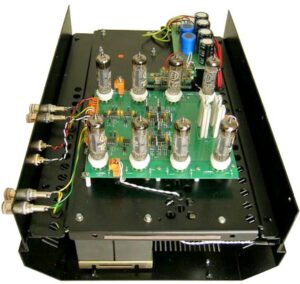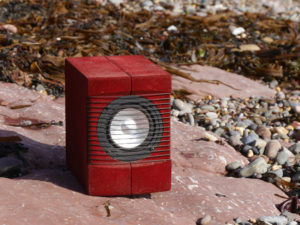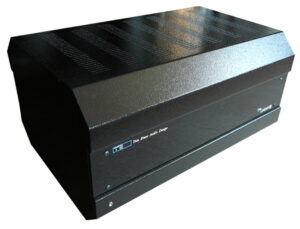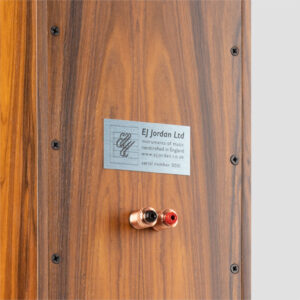Tom Evans is an electronics designer whose work has achieved a genuinely high regard in the audiophile world. Creative and innovative, his designs are at the cutting edge, and include the Michel Iso and Argo, the A-300R Precision (a heavily modified version of Pioneer’s classic integrated amplifier) as well as his current TEAD range.
Tom’s relationship with EJ Jordan Ltd – and, in particular, company founder Ted Jordan – goes back many years. We recently asked him about this and why Jordan drivers are so important to his work:

When I’d been designing products for other companies, I’d had access to quite a range of different speakers. You can listen to them for a while and you can realise there’s something wrong with them. Then I tried Max Townshend’s Glastonbury, which used a ribbon tweeter and Ted Jordan’s J125 mid/woofer alloy cone driver. That was quite a revelation.
So I phoned Ted up and said we ought to meet for a chat. It was a lovely summer’s day; he was concentrating on learning Greek – he was off to Greece for a few days – so I said rather than suffer listening to language records, invite me over and I’ll teach you how to speak it properly (my mother was Greek). And at the same time, we can chat about a few things.
I went over to teach the basics of Greek and eventually we got to the point of discussing and listening to his loudspeakers. Certain parameters of his drivers suited the design direction I was taking with my amplifiers and I realised that if we put the two together, we got a kind of magic, with a sound that was more accurate to the original recording.
I needed a speaker that was relatively neutral but very, very revealing and Ted’s drivers, used correctly, were just that. It allowed me to move forward with my designs.
Later, Paddy Hanscombe (of Electrofluidics) and I helped Ted get the JX92 full-range driver into production. That was quite an eye-opener into what you could do with just one driver. It was so revealing of the amplifier that I could really hear what I was doing.

Acoustic Precision Eikos FR1
I started thinking about a box to put it in. The JX92 was such a wide bandwidth, low distortion driver, it was a shame to have a box hooting away at low frequencies. A conventional wooden box has a lot of mass, it will store the energy and you get this sort of blur; it buries the detail.
There are usually two ways of dealing with this; you come up with a box that has got so much mass you can’t vibrate it, or use a box with ultra-low mass so it can’t store the energy.
I began experimenting by hacking out a block of polystyrene and painting it inside and out to give it a more rigid shell. Once the driver was mounted, you could clearly hear that the box was no longer contributing to the low frequencies and the individual bass notes were much more distinct.
[Editor’s Note: The Jordan Marlow cabinets take a third approach, using mass to tune a lightweight cabinet and push the resonances to a lower level.]
Production of the Eikos FR1 was an expensive exercise but it was fun doing it. We used a higher quality material and to make it stronger, the enclosure was sprayed with a coloured resin. Once it set, it provided us with the ideal tough outer skin. We made a lot of different finishes, and certainly many colours. I’ve still got a pair here that have a zebra finish. The FR1 sold well and continued in production until the JX92 was no longer available.
Jordan Marlow CE copper binding posts
Copper binding posts
Later, I came to develop a two-box design with the JX92. The prototype was hard-wired, but the production version used conventional brass loudspeaker posts. I could hear that the production version had a kind of broadband mush to the sound although the only difference was the use of binding posts rather than the hard-wiring of the prototype.
So to investigate this, I had several binding posts made in different sizes and out of different grades of copper. I listened to the effects of them all and, in the end, the conclusion was that these ones we have now sounded far better than any of them. There is a clarity and they are far more natural. The effect is broadband, it’s not just at high frequency; it affects all the frequencies.
Anything out there with brass binding posts, the Marlow CE will murder. Using conventional brass posts, the audio signal will be corrupted before they even get to the drivers.
The JX92 and the Eikona show this up so well – any tiny change in the system is brutally obvious. And that’s the joy of designing with Jordan loudspeakers, it’s exactly what you’re looking for as an amplifier designer.

Current amplifier design
All this has enabled us to push ahead with our amplifier development. The hybrid triode power amps we make now are in a different league to earlier designs and allow us to explore all sorts of different areas.
For example, the importance of the output transformer being able to match the varying impedance of the loudspeaker is much misunderstood. Our output transformers are wound by us and they have a wide operating window, so they’re able to match the varying impedance, which means you don’t get a variation in power level in the room. Ted’s speakers, like the JX92 and the Eikona, don’t vary that much in impedance or phase across their frequency range and that’s ideal.
When you look at what’s going on in the industry, you see loudspeakers, from well-known manufacturers, which have a nominal eight ohm impedance but on the impedance plot they dip to about three ohms. A transistor amplifier is going to double its power at that frequency and so you’re not going to get a flat frequency response. That’s another reason for using Ted’s designs. It’s matching the amplifier with the speaker – that’s a big part of the story.
Our two new power amplifiers are very special – the input stages have IMD figures of -150 dB. The Linear A has a triode output stage and because you have so little distortion from the input stage, the overall distortion is extremely low – it sounds real, it makes music, which is what we’re all looking for.
The Linear A is a 25w stereo single-ended triode power amp, and the Linear B is a 55-60 mono push-pull power amp. I hesitate to call it a push-pull as there isn’t a phase splitter, the two halves are exactly 180º out of phase and are physically identical. I’ve just measured the performance of that and it is really quite astonishing – 10 Hz to 191 kHz without feedback. They have user-variable feedback from zero to plus 6 dB on the monos, so that just extends it further. The full power bandwidth was 50 kHz on zero feedback.
If you put any of Ted’s driver technology on the end of them, they really do sound real.
You can find more information about Tom’s latest power amp and preamp designs at http://www.audiodesign.co.uk


